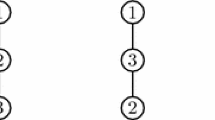Abstract
The ladder structure is briefly explained, and its essential characteristics described. Using Kummer's functional equations and a generalization of Roger'sL-function, it is proved that a) the transcendental part of the ladder retains its structure when the order is decreased; b) the logarithmic part also retains its structure; and c) as a special case of the latter, a cyclotomic equation for the variable, as previously observed empirically, can be shown to be satisfied. With some refinements, the order can also be increased beyond the fifth, to where there currently are no known relevant functional equations. Flow charts are given to show the structure of the order-augmentation process. The existence of a new category of such functional equations is conjectured, and some examples, for lower orders, are presented.
Similar content being viewed by others
References
Euler, L.,Institutiones calculi integralis, Vol. 1, 1768, pp. 110–113.
Landen, J.,Mathematical Memoirs, Vol. 1, 1780, p. 112.
Watson, G. N.,A note on Spence's logarithmic transcendent, Quart. J. Math. Oxford8 (1937), 39–42.
Coxeter, H. S. M.,The functions of Schäfli and Lobatschefsky. Quart. J. Math. Oxford6 (1935), 13–29.
Lewin, L.,The dilogarithm in algebraic fields. J. Austral. Math. Soc. Ser. A33 (1982), 302–330.
Lewin, L.,The inner structure of the dilogarithm in algebraic fields. J. Number Theory19 (1984), 345–373.
Lewin, L. andAbouzahra, M.,The polylogarithm in algebraic number fields. To appear in J. Number Theory.
Loxton, J. H.,Special values of the dilogarithm function. Acta Arithmetica43 (1984), 155–166. Also discussed in Richmond, B. and Szekeres, G.,Some formulas related to dilogarithms, the zeta function and the Andrews-Gordon indentities. J. Austral. Math. Soc. Ser. A31 (1981), 362–373.
Kummer, E. E.,Ueber die Transzendenten, welche aus wiederholten Integrationen rationaler Funktionen entstehen. J. Mathematik,21 (1840), 74–90, 193–225, 328–371.
Wechsung, G.,Über die Unmöglichkeit des Vorkommens von Funktionalgleichungen gewisser Struktur für Polylogarithmen. Aequationes Math.5 (1970), 54–62.
Rogers, L. J., On function sum theorems connected with the series\(\sum\limits_{n = 1}^\infty {x^n /n^2 } \). Proc. London Math. Soc. (2)4 (1907), 169–189.
Lewin, L.,Polylogarithms and associated functions. North-Holland Publishing Co., New York-Amsterdam, 1981.
Wechsung, G.,Lineare Funktionalgleichungen von Polylogarithmen. Wiss. Z. Friedrich-Schiller-Univ. Jena/Thüringen14 (1965), 401–408.
Mantel, W.,Dilogarithmen. Nieuw Archief (2)3 (1898), 292–320.
Hill, C. J.,Ueber die Integration logarithmisch-rationaler Differentiale. J. Reine Angew. Math.3 (1828), 101–159.
Lewin, L.,New categories of polylogarithmic functional equations. To appear.
Lewin, L.,Polylogarithmic ladders to the sixth order for the base ϑ, (ϑ3 + ϑ = 1). To appear.
Author information
Authors and Affiliations
Rights and permissions
About this article
Cite this article
Lewin, L. The order-independence of the polylogarithmic ladder structure—implications for a new category of functional equations. Aeq. Math. 30, 1–20 (1986). https://doi.org/10.1007/BF02189908
Received:
Issue Date:
DOI: https://doi.org/10.1007/BF02189908



